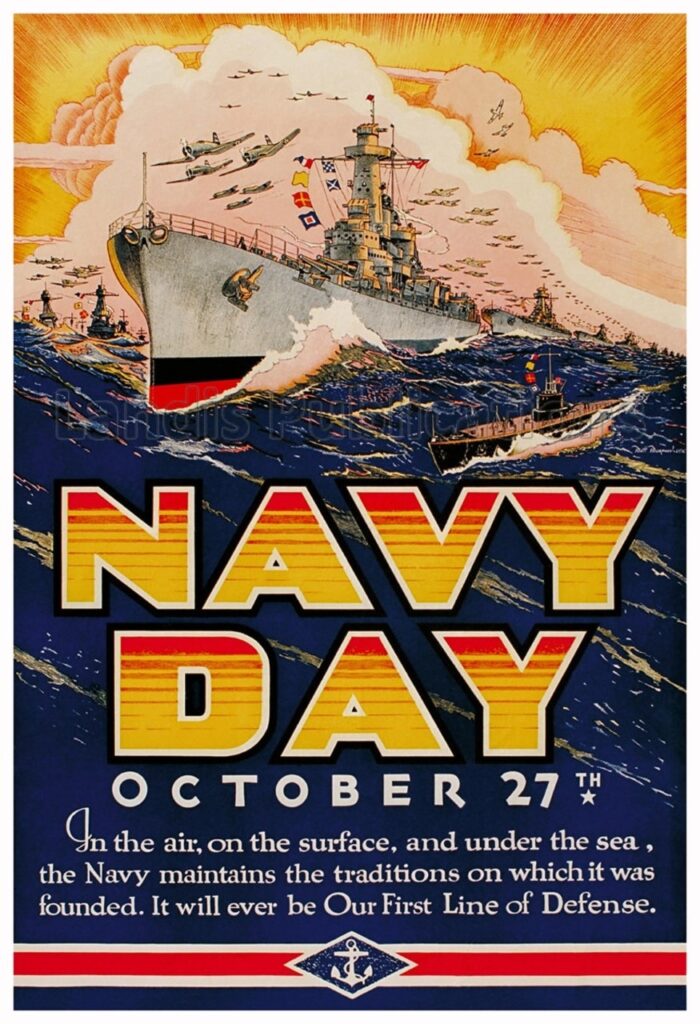By David F. Winkler, Ph.D.
Staff Historian
Today marks the centennial of the first “Navy Day” existence. With the belief that a naval arms race had been a leading cause for World War I, general public sentiment supported President Warren G. Harding’s call in June 1921 to convene a Washington Naval Arms Conference. As documented in Ryan Wadle’s book Selling Sea Power, Navy leaders felt betrayed by the national leadership that had convened and approved of the outcome of the conference that curbed new battleship construction and invoked tonnage limits on other ship classes. Thus, they orchestrated through the Navy League of the United States a celebration that would be held on the birthdate of recently deceased President Theodore Roosevelt.
The Navy League proved to be a willing orchestrator. Membership was in decline and in 1921 the publication of Sea Power ceased. Fortunately, President Warren Harding endorsed the concept and Navy League chapters across the country mobilized to stage events in honor of those who wore the naval uniform. The Navy made its ships available for visitation. For this inaugural event, Langley’s crew “dressed ship” by hanging signal flags from a line that extended up from the bow over the two telescoping masts and down to the stern. Some 1,500 visitors visited the Navy’s first aircraft carrier that had gained attention in the national media.
Initially designed to be a one-time event to “rally the troops,” the success of the 1922 “Navy Day” led the Navy League to institutionalize the day as an annual event. Hard work by Navy Leaguers to promote the 1923 celebration quickly gained recognition at the highest levels. In a letter dated 29 August, new President Calvin Coolidge expressed his pleasure over the Navy League’s decision to continue the 27 October event, citing the service as the nation’s first line of defense.
Besides the president, Navy League chapters lined up endorsements and proclamations from 35 governors and numerous other public figures. Leaders of many veterans groups urged their members to join in local commemorations acknowledging the service and sacrifice made by past and present bluejackets. Fifty of the nation’s largest cities staged observances and the Navy participated by deploying at least one or two vessels to major and minor ports along the nation’s seaboard. Thirty radio stations broadcast speeches by prominent citizens about the Navy and hundreds of newspapers provided coverage about the Navy with two thirds of these papers lauding the sea service in their editorial sections. Papers that a year earlier had questioned the need for such a day joined in on the chorus.
With the Navy League revitalized, Navy Day became imbedded on the American calendar as day of celebration. The 1945 celebration was particularly joyous, coinciding with the return of many fleet units from their World War II service to ports along America’s coasts. In New York, President Harry Truman reviewed the fleet, joined in a ticker tape parade, and gave his national Navy Day address.
On August 31, 1949, Secretary of Defense Louis Johnson directed the folding in of Navy Day into an Armed Forces Day to be held in May. However, while Johnson can take credit canceling the aircraft carrier United States, his edict hardly put a damper on the October 27 festivities. Navy Day continued and prospered during the 1950s and 60s.
In the early 1970s historical research revealed that the Continental Congress had first authorized funds for Navy ships on October 13, 1775. With a Navy birth date established, in 1972 Chief of Naval Operations Admiral Elmo Zumwalt arranged with the Navy League to move the Navy Day celebration up two weeks to the new date. In three years, that date will be used to mark the 250th birthday of the United States Navy.



Larry Groves